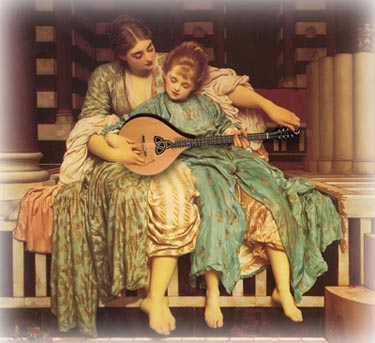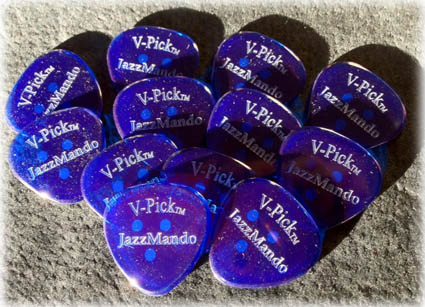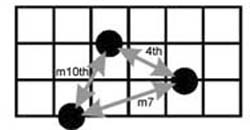« February 2012 |
Main
| April 2012 »
 March 29, 2012 | Best of JM: Enemies of Sustain
March 29, 2012 | Best of JM: Enemies of Sustain
Enjoy the popular archive material below.
From July 4, 2007: "Enemies of Sustain"
We've had pretty good feedback on the MandolinSessions article published last April (2007), Thinking Good Tone Part 1: What the Pros say about Good Tone. Possibly the single most "make it or break it" factor in good tone lies in the issue of sustain. Three different factors impact whether or not your playing is capable of good sustain, fretting, picking, and Right Hand/Left Hand coordination.
Fretting. When your fingers hold the note, pressure has to be not only powerful enough, but nailed to the "sweet spot" between the frets, and held long enough to blow into the next note. It needs to be set perfectly and can't be cut prematurely. Paul Glasse mentions the magic midway, just enough pressure to bring the tone to its maximum, but light enough to remain fluid.
Picking. It all starts with the pick. You can't have sustained good tone until you start good tone. Proper "snap," enough force to start the tone with confidence and security, even in the soft passages requires impeccable picking. This is why we recommend spending 10 minutes at the start of every practice session. (See Good Tone Part 2 for a terrific exercise to woodshed this in your playing.)
Right Hand/Left Hand Coordination. Putting it all together is a true art. Listen to recordings of John Reischman the hallmark of amazing control, he's the real deal when it comes to dispensing fluidity (and of course accuracy). Typically, the "motor boat" propeller style of bluegrass picking does not require good sustain. The emphasis in sound of this genre will always be projection; the start of a note more profoundly impacts the discernability in this music. In jazz & classical, we seek notes that connect, even at rapid tempos.
 Reviewing, the death of sustain is most obvious when you lift the fretting finger prematurely. You can't connect a group of notes into a phrase unless finger pressure lingers long enough. This is remedied best by working on slow, long tones, focusing on keeping the string vibration active until the start of the next note. Picking deficiency isn't quite as obvious, but a healthy pick stroke can't be taken for granted. The third concern, coordination of the two is a bit more complex issue. Reviewing, the death of sustain is most obvious when you lift the fretting finger prematurely. You can't connect a group of notes into a phrase unless finger pressure lingers long enough. This is remedied best by working on slow, long tones, focusing on keeping the string vibration active until the start of the next note. Picking deficiency isn't quite as obvious, but a healthy pick stroke can't be taken for granted. The third concern, coordination of the two is a bit more complex issue.
Consider a merry-go-round. Activating this classic child's playground equipment requires a coordination of propulsion and proper timing. If you push too late, you obstruct and actually end up slowing the motion down. If you push too soon, you use an improper and inefficient degree of force.
This is no different than your picking. Listen to some poorly executed cross-picking or a failed bluegrass breakdown and you get the picture. A pick timed too late actually stops the sound, and you get "coughs" in the flow of tone.
Pay attention to your pick timing. You never impress your fellow musicians or any audience with bad tone, not even bad tone at lightning tempo. Don't be afraid to slow hard passage down to a comfortable level of speed and control.
Posted by Ted at 6:32 AM
 March 22, 2012 | The Muse Continuum. Improvisation and Inspiration.
March 22, 2012 | The Muse Continuum. Improvisation and Inspiration.
We're in the process of writing our final Mandolin Sessions article (see archives). Sad to see this great resource come to an end this year, but we are promised the archives will remain indefinitely, and of course there's plenty of material already there to explore and revisit. Get done? Go back and start all over again. It's that full of treasure.

We wanted to go out with a bang, so we enlisted the help of the current mandolin giants, big names youve come to know and cherish, asking where their Muse came from, based on this premise:
An artist has two sides in attacking a solo. One is objective, the intellectual, the analysis of chord structure, modes, arpeggios, riff repetition and regeneration of familiar motifs. The other is subjective, innate, intuitive--the spontaneous creation of "the Muse," material that's inspired or seems to come out of nowhere. The first is conscious and calculated, the second is subconscious, reactive, indefinable and illusively of the moment.
The question for you is where does your material come from? No doubt its a combination of both, but how would describe the sparks in your individual creative process? What are the elements, how do other great artists or other ensemble members impact your playing, what makes for a more satisfying solo for you, your bandmates, and your audience?
What's interesting is out of the eleven professionals we asked this, we received eleven astute but different answers. When it comes to improvisation, there really is more than one way to skin a cat. Certainly there was some commonality. Nobody wrote off knowing your theory. Nobody depended entirely on bare soul, either. It was all part of a continuum of sorts. Some had neat tricks, singing your lines, constructing a beginning and a thoughtful end, filling out the middle. Many emphasized playing off each other and being "in the moment." One offered melding left side brain with right, and one compared improvisation to madness.
Literally.
We'll be looking forward to sharing these answers in the coming months. Meanwhile, check out some of our previous articles on the topic in our "Further" listings below.
Further:
Don Stiernberg: Axis of the 3rds & 7ths
More Appropriate
Major 7th Arpeggios
Improvisation Techniques
Lydian Tracks Pt. 1: A Path to Modal Improvising
Lydian Tracks Pt. 2: A Path to Modal Improvising
Posted by Ted at 7:47 AM
 March 15, 2012 | Patience with picks
March 15, 2012 | Patience with picks

Many like to experiment with picks. It can be an addiction, and one we'll never understand.
There's a camp out there that finds the perfect pick and sticks with it, developing technique around the product, not the other way around. Granted, it's an inexpensive way to change up your sound, but you don't want risk the distraction of gear envy with developing the physical strategies of beautiful tone production.
A beginner's journey should probably start on the mandolin with a relatively thick pick. 1 to 1.5 mm, is the general consensus, if your goal is to pull rich harmonic fundamental out of the string. A guitarist convert will probably feel more comfortable with something thinner (.60-.90), sacrificing speed and flexibility for robust tone. We encourage you to be patient with the thick pick. The control you think you're gaining with the thin pick is far less important to playing the mandolin's piercing soprano register. This is not a guitar.
Flexibility in a pick is not the concern with mandolin that it is with a guitar. At 1.5 mm, no matter the construction, there just isn't going to be a lot of give to any material. Really the only concern in construction will be weight, shape, and bevel. The thick pick will almost always be heavier; again, that's a good thing. Some use even heavier, 2.0mm and up, but the trade off here is control. You also have to finesse the edges on these so you can still articulate notes effectively.
A rounded bevel takes the attack out of the string. The thinner gauge already has a shrill sound, so you want a pick edge that will pull the lower harmonics of the string and reduce the "clacky" articulation and boost tone from the bottom up harmonically.
Fingers are like snowflakes, and every one's is different. You may end up liking a larger shape, rounded triangle, or more of the traditional Fender 351 shape. The benefit of a rounded equilateral triangle is you have three times the number of corners to use. This is worth experimenting, but do it over a long period of time. Don't immediately write off a new shape without several hours of playing.
Be patient.
Further
Prescription strength. Tone.
Deconstructing Mandolin Picks
Guitar to Mandolin
Starting with good tone
Picks and Doorknobs
Posted by Ted at 2:51 PM
 March 8, 2012 | Chord economy
March 8, 2012 | Chord economy
It's easy to go through life just acquiring chords. Find a new fingering in context and slap it on to your personal chord vocabulary. Years of playing experience, you'll accumulate a healthy arsenal of chords, but sometimes knowing what's under the hood can put the fretboard journey into hyperdrive.
We've talked about this before in expanding the library, exploring what we call "chord economics." The fact we only have four voices with our eight strings limits how many notes of a complex extended chord we can express. The good news is despite the six note complexity in a Maj13 chord, we don't have to cut the proverbial baby in half. Knowing which tones are important, which are superfluous, we can walk proudly into a jam session and still speak the jazz dialect fluently. You just have to know some of the chemistry of the chord.
CHORD VOICE PRIORITIES
Tonality: (Someone else's job!)
Third: Majorness/Minorness
Fifth: (always implied except when diminished or augmented)
Seventh: Stability resolved or "to be" resolved)
Color: (Extensions)
On the above list, if you're playing in a group, the tonality of the chord (the root) is generally covered by the bass (or the lowest note of an instrument lower than the mandolin), so you can chalk that one off. The 3rd is important because of its disclosure of majorness/minorness. The 5th is implied (unless your playing a b5 or Augmented chord), so leave it out. The 7th is important because of its stability, the "resolve me" factor. The last note(s), the 9th or 13th are your color tones. They aren't necessary but they are the delicious frosting on the cake.
In other words, you really only need three, 3rd, 7th, and color extension. Nothing wrong with having a root in there, and if you're playing solo, you want it injected as often as possible. Now you can see the fluidity that remains in four voices. Add the dimension of time, the aural permanence for the ear playing several inversions of the same chord before it changes in the music, and we really strut our harmonic prowess.
Check out some of our other articles on the nature of chord economics.

Further
Three's company. 3-note chord
Axis of the 3rd & 7ths
Mandolin Chord Economics
Need a chord?
New ways to comp with V7 chords
Posted by Ted at 8:31 AM
 March 1, 2012 | Left hand hover
March 1, 2012 | Left hand hover
Enjoy the popular archive material below.
From February 2, 2007: "Left hand hover"
Advanced beginning/intermediate mandolinists often ask, "where do I keep my left hand?" The context is the player desiring a liberation from the first 6 frets, that perpetual open-string anchor of the lower end of the fingerboard. Yes, we all start learning the instrument there, but once we seek the broader perspective of higher fret altitude, the question remains, where does one "hover?" Should the right hand stay low and make jumps as needed, completely avoid the lower frets, or anchor somewhere in between?
Answer: Yes.

Certainly, it's a combination. The discipline of avoiding open strings is purely for practice. Nothing wrong with using them, in fact the rich fundamentals and overtones of an open string are terrific for the inherent beauty of the instrument. The problem is many players never leave, so we advocate minimizing their use during practice. The 7th-15th frets can sound somewhat thinner in timbre, but you want to use them, too. Get familiar because they can be your friend in opening up new fingering horizons.
The question is "hover." Watch a good jazz guitar player and see where the left hand stays. Not uncommonly you'll see this in the 5th or 7th fret, and it makes sense. You have quicker access to the upper and lower extremes. You have a richness in tone. Mandolin is similar, although because of its more limited soprano register, you're probably better off using the 3rd fret as your base.
We discuss this in more detail in the February Mandolin Sessions submission.
Read article: Leading off third base; The benefits of third position playing.
Assignment: Watch videos of great jazz guitar players on YouTube.
Further:
FFcP vs Traditional Violin Positions Fingering
Transition: Moving the up the Fingerboard
Top Five 'Hover' Tones
Maximizing the "E" Zone
E's & W's: Tone and transition while chording
Posted by Ted at 7:43 PM

Disclaimer: In the 'Information Age' of the 21st Century,
any fool with a computer, a modem, and an idea can
become a self-professed 'expert." This site does not
come equipped with 'discernment.'
|



